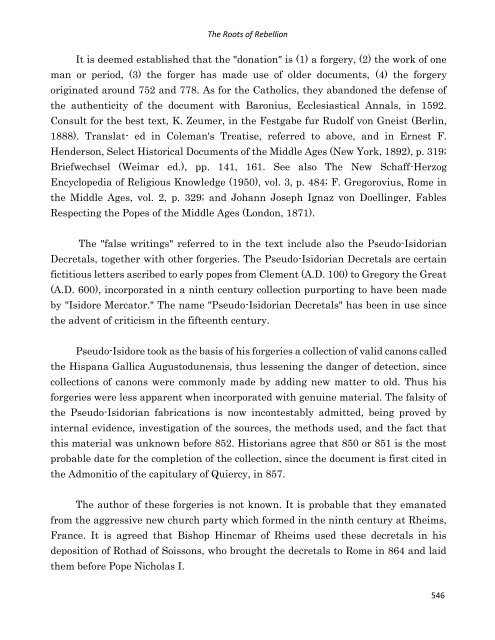- Page 2 and 3:
Ellen G. White The Roots of Rebelli
- Page 4 and 5:
The Roots of Rebellion Information
- Page 6 and 7:
The Roots of Rebellion 1. World His
- Page 8 and 9:
The Roots of Rebellion had continue
- Page 10 and 11:
The Roots of Rebellion destroyed, t
- Page 12 and 13:
The Roots of Rebellion taught and h
- Page 14 and 15:
The Roots of Rebellion revealed the
- Page 16 and 17:
The Roots of Rebellion wonders appe
- Page 18 and 19:
The Roots of Rebellion their own ch
- Page 20 and 21:
The Roots of Rebellion of the mount
- Page 22 and 23:
The Roots of Rebellion obey not the
- Page 24 and 25:
The Roots of Rebellion entertainmen
- Page 26 and 27:
The Roots of Rebellion they could m
- Page 28 and 29:
The Roots of Rebellion falsehood an
- Page 30 and 31:
The Roots of Rebellion destruction.
- Page 32 and 33:
The Roots of Rebellion acknowledge
- Page 34 and 35:
The Roots of Rebellion Constantine
- Page 36 and 37:
The Roots of Rebellion the minds of
- Page 38 and 39:
The Roots of Rebellion come into hi
- Page 40 and 41:
The Roots of Rebellion The palaces
- Page 42 and 43:
The Roots of Rebellion When the Sax
- Page 44 and 45:
The Roots of Rebellion Among the le
- Page 46 and 47:
The Roots of Rebellion to bear resp
- Page 48 and 49:
The Roots of Rebellion France or It
- Page 50 and 51:
The Roots of Rebellion their minds
- Page 52 and 53:
The Roots of Rebellion just as I am
- Page 54 and 55:
The Roots of Rebellion The papal le
- Page 56 and 57:
The Roots of Rebellion and he under
- Page 58 and 59:
The Roots of Rebellion their own li
- Page 60 and 61:
The Roots of Rebellion Lutterworth.
- Page 62 and 63:
The Roots of Rebellion firm, strong
- Page 64 and 65:
The Roots of Rebellion "With whom,
- Page 66 and 67:
The Roots of Rebellion So broad and
- Page 68 and 69:
The Roots of Rebellion The papists
- Page 70 and 71:
The Roots of Rebellion as a charity
- Page 72 and 73:
The Roots of Rebellion who looked u
- Page 74 and 75:
The Roots of Rebellion the people.
- Page 76 and 77:
The Roots of Rebellion wearing rich
- Page 78 and 79:
The Roots of Rebellion great sacrif
- Page 80 and 81:
The Roots of Rebellion enemies, fea
- Page 82 and 83:
The Roots of Rebellion In self-repr
- Page 84 and 85:
The Roots of Rebellion of Sigismund
- Page 86 and 87:
The Roots of Rebellion A large clas
- Page 88 and 89:
The Roots of Rebellion 7. A Revolut
- Page 90 and 91:
The Roots of Rebellion read for him
- Page 92 and 93:
The Roots of Rebellion where he wou
- Page 94 and 95:
The Roots of Rebellion had been wit
- Page 96 and 97:
The Roots of Rebellion trust to its
- Page 98 and 99:
The Roots of Rebellion In the confl
- Page 100 and 101:
The Roots of Rebellion body: let th
- Page 102 and 103:
The Roots of Rebellion With many fo
- Page 104 and 105:
The Roots of Rebellion the universi
- Page 106 and 107:
The Roots of Rebellion men, once ev
- Page 108 and 109:
The Roots of Rebellion 8. Tried Bef
- Page 110 and 111:
The Roots of Rebellion appear and p
- Page 112 and 113:
The Roots of Rebellion A committee
- Page 114 and 115:
The Roots of Rebellion as if spellb
- Page 116 and 117:
The Roots of Rebellion tribunal whi
- Page 118 and 119:
The Roots of Rebellion With his min
- Page 120 and 121:
The Roots of Rebellion reasoning, u
- Page 122 and 123:
The Roots of Rebellion sacrifice my
- Page 124 and 125:
The Roots of Rebellion Frederick of
- Page 126 and 127:
The Roots of Rebellion in its conde
- Page 128 and 129:
The Roots of Rebellion 9. Reform in
- Page 130 and 131:
The Roots of Rebellion explain Scri
- Page 132 and 133:
The Roots of Rebellion and the infl
- Page 134 and 135:
The Roots of Rebellion hands of the
- Page 136 and 137:
The Roots of Rebellion The council
- Page 138 and 139:
The Roots of Rebellion The contrast
- Page 140 and 141:
The Roots of Rebellion A few men, d
- Page 142 and 143:
The Roots of Rebellion In a letter
- Page 144 and 145:
The Roots of Rebellion learned the
- Page 146 and 147:
The Roots of Rebellion apostles, an
- Page 148 and 149:
The Roots of Rebellion Reformation
- Page 150 and 151:
The Roots of Rebellion notwithstand
- Page 152 and 153:
The Roots of Rebellion Could they c
- Page 154 and 155:
The Roots of Rebellion is no sure d
- Page 156 and 157:
The Roots of Rebellion order agains
- Page 158 and 159:
The Roots of Rebellion In the days
- Page 160 and 161:
The Roots of Rebellion To Melanchth
- Page 162 and 163:
The Roots of Rebellion of the saint
- Page 164 and 165:
The Roots of Rebellion As travelers
- Page 166 and 167:
The Roots of Rebellion arms which t
- Page 168 and 169:
The Roots of Rebellion and applicat
- Page 170 and 171:
The Roots of Rebellion an able comb
- Page 172 and 173:
The Roots of Rebellion The French R
- Page 174 and 175:
The Roots of Rebellion disappeared.
- Page 176 and 177:
The Roots of Rebellion A solemn oat
- Page 178 and 179:
The Roots of Rebellion gospel. The
- Page 180 and 181:
The Roots of Rebellion created, the
- Page 182 and 183:
The Roots of Rebellion Protestants
- Page 184 and 185:
The Roots of Rebellion gospel. From
- Page 186 and 187:
The Roots of Rebellion blood of its
- Page 188 and 189:
The Roots of Rebellion presented in
- Page 190 and 191:
The Roots of Rebellion 14. England
- Page 192 and 193:
The Roots of Rebellion supposing th
- Page 194 and 195:
The Roots of Rebellion Hamilton and
- Page 196 and 197:
The Roots of Rebellion testimony. M
- Page 198 and 199:
The Roots of Rebellion manifested a
- Page 200 and 201:
The Roots of Rebellion of forming a
- Page 202 and 203:
The Roots of Rebellion Said John We
- Page 204 and 205:
The Roots of Rebellion in the Ten C
- Page 206 and 207:
The Roots of Rebellion lesson of pr
- Page 208 and 209:
The Roots of Rebellion the Spirit o
- Page 210 and 211:
The Roots of Rebellion It had been
- Page 212 and 213:
The Roots of Rebellion were counted
- Page 214 and 215:
The Roots of Rebellion Communion we
- Page 216 and 217:
The Roots of Rebellion long afterwa
- Page 218 and 219:
The Roots of Rebellion "But a blind
- Page 220 and 221:
The Roots of Rebellion policy, was
- Page 222 and 223:
The Roots of Rebellion Catholic cle
- Page 224 and 225:
The Roots of Rebellion The restrain
- Page 226 and 227:
The Roots of Rebellion 16. The Pilg
- Page 228 and 229:
The Roots of Rebellion When first c
- Page 230 and 231:
The Roots of Rebellion attempt to p
- Page 232 and 233:
The Roots of Rebellion To secure th
- Page 234 and 235:
The Roots of Rebellion became corru
- Page 236 and 237:
The Roots of Rebellion and the Lord
- Page 238 and 239:
The Roots of Rebellion consequently
- Page 240 and 241:
The Roots of Rebellion bar dry; it
- Page 242 and 243:
The Roots of Rebellion "The extent
- Page 244 and 245:
The Roots of Rebellion prophet of G
- Page 246 and 247:
The Roots of Rebellion not occupy t
- Page 248 and 249:
The Roots of Rebellion land of the
- Page 250 and 251:
The Roots of Rebellion 18. An Ameri
- Page 252 and 253:
The Roots of Rebellion I had not se
- Page 254 and 255:
The Roots of Rebellion 24:30, 27. H
- Page 256 and 257:
The Roots of Rebellion serious cons
- Page 258 and 259:
The Roots of Rebellion brought it t
- Page 260 and 261:
The Roots of Rebellion 1810 Days/ Y
- Page 262 and 263:
The Roots of Rebellion "With the so
- Page 264 and 265:
The Roots of Rebellion Reformers, t
- Page 266 and 267:
The Roots of Rebellion accomplishme
- Page 268 and 269:
The Roots of Rebellion Despite all
- Page 270 and 271:
The Roots of Rebellion praising and
- Page 272 and 273:
The Roots of Rebellion Why, then, t
- Page 274 and 275:
The Roots of Rebellion Yet while it
- Page 276 and 277:
The Roots of Rebellion they had dec
- Page 278 and 279:
The Roots of Rebellion understandin
- Page 280 and 281:
The Roots of Rebellion In explainin
- Page 282 and 283:
The Roots of Rebellion With these b
- Page 284 and 285:
The Roots of Rebellion Lord. The "m
- Page 286 and 287:
The Roots of Rebellion with grief,"
- Page 288 and 289:
The Roots of Rebellion stripped of
- Page 290 and 291:
The Roots of Rebellion It was while
- Page 292 and 293:
The Roots of Rebellion continued hi
- Page 294 and 295:
The Roots of Rebellion Farmers left
- Page 296 and 297:
The Roots of Rebellion world?" Jesu
- Page 298 and 299:
The Roots of Rebellion were still w
- Page 300 and 301:
The Roots of Rebellion About this t
- Page 302 and 303:
The Roots of Rebellion dissension e
- Page 304 and 305:
The Roots of Rebellion he says: "I
- Page 306 and 307:
The Roots of Rebellion Besides a si
- Page 308 and 309:
The Roots of Rebellion a talented m
- Page 310 and 311:
The Roots of Rebellion cannot becom
- Page 312 and 313:
The Roots of Rebellion 22. Propheci
- Page 314 and 315:
The Roots of Rebellion the wise too
- Page 316 and 317:
The Roots of Rebellion was in Paul'
- Page 318 and 319:
The Roots of Rebellion That which l
- Page 320 and 321:
The Roots of Rebellion It caused a
- Page 322 and 323:
The Roots of Rebellion reproach and
- Page 324 and 325:
The Roots of Rebellion of Jonah was
- Page 326 and 327:
The Roots of Rebellion 23. What is
- Page 328 and 329:
The Roots of Rebellion manna, and A
- Page 330 and 331:
The Roots of Rebellion The matchles
- Page 332 and 333:
The Roots of Rebellion the pierced
- Page 334 and 335:
The Roots of Rebellion Once a year,
- Page 336 and 337:
The Roots of Rebellion by Daniel th
- Page 338 and 339:
The Roots of Rebellion prophet Dani
- Page 340 and 341:
The Roots of Rebellion Priest which
- Page 342 and 343:
The Roots of Rebellion in with Him
- Page 344 and 345:
The Roots of Rebellion of Christ in
- Page 346 and 347:
The Roots of Rebellion 25. God's La
- Page 348 and 349:
The Roots of Rebellion Those who ha
- Page 350 and 351:
The Roots of Rebellion idolater, an
- Page 352 and 353:
The Roots of Rebellion -G. A. Towns
- Page 354 and 355:
The Roots of Rebellion civil govern
- Page 356 and 357:
The Roots of Rebellion of God's law
- Page 358 and 359:
The Roots of Rebellion The Roman Ch
- Page 360 and 361:
The Roots of Rebellion 26. A Work o
- Page 362 and 363:
The Roots of Rebellion testimony ha
- Page 364 and 365:
The Roots of Rebellion sufficient t
- Page 366 and 367:
The Roots of Rebellion Now as in fo
- Page 368 and 369:
The Roots of Rebellion 27. Revival
- Page 370 and 371:
The Roots of Rebellion consecration
- Page 372 and 373:
The Roots of Rebellion Many religio
- Page 374 and 375:
The Roots of Rebellion guilt and un
- Page 376 and 377:
The Roots of Rebellion 12:2-4, marg
- Page 378 and 379:
The Roots of Rebellion best possibl
- Page 380 and 381:
The Roots of Rebellion worthy of pr
- Page 382 and 383:
The Roots of Rebellion 28. Facing L
- Page 384 and 385:
The Roots of Rebellion judgment." S
- Page 386 and 387:
The Roots of Rebellion creation; bu
- Page 388 and 389:
The Roots of Rebellion mistakes in
- Page 390 and 391:
The Roots of Rebellion work which a
- Page 392 and 393:
The Roots of Rebellion pronounce th
- Page 394 and 395:
The Roots of Rebellion that are in
- Page 396 and 397:
The Roots of Rebellion God in His g
- Page 398 and 399:
The Roots of Rebellion Satan had ma
- Page 400 and 401:
The Roots of Rebellion this apostat
- Page 402 and 403:
The Roots of Rebellion proves it im
- Page 404 and 405:
The Roots of Rebellion where hither
- Page 406 and 407:
The Roots of Rebellion such company
- Page 408 and 409:
The Roots of Rebellion 31. Evil Spi
- Page 410 and 411:
The Roots of Rebellion they are lea
- Page 412 and 413:
The Roots of Rebellion Those posses
- Page 414 and 415:
The Roots of Rebellion 32. Deadly D
- Page 416 and 417:
The Roots of Rebellion The vague an
- Page 418 and 419:
The Roots of Rebellion intend that
- Page 420 and 421:
The Roots of Rebellion Innumerable
- Page 422 and 423:
The Roots of Rebellion There is but
- Page 424 and 425:
The Roots of Rebellion 33. First Gr
- Page 426 and 427:
The Roots of Rebellion made to mean
- Page 428 and 429:
The Roots of Rebellion theologians,
- Page 430 and 431:
The Roots of Rebellion opened, and
- Page 432 and 433:
The Roots of Rebellion God has give
- Page 434 and 435:
The Roots of Rebellion In mercy He
- Page 436 and 437:
The Roots of Rebellion the living,
- Page 438 and 439:
The Roots of Rebellion Jude refers
- Page 440 and 441:
The Roots of Rebellion 34. Can Our
- Page 442 and 443:
The Roots of Rebellion heaven on th
- Page 444 and 445:
The Roots of Rebellion their though
- Page 446 and 447:
The Roots of Rebellion the bewitchi
- Page 448 and 449:
The Roots of Rebellion They affect
- Page 450 and 451:
The Roots of Rebellion "There are m
- Page 452 and 453:
The Roots of Rebellion Brilliancy o
- Page 454 and 455:
The Roots of Rebellion of torture t
- Page 456 and 457:
The Roots of Rebellion all evil, an
- Page 458 and 459:
The Roots of Rebellion and flattere
- Page 460 and 461:
The Roots of Rebellion ninth hour,
- Page 462 and 463:
The Roots of Rebellion the downfall
- Page 464 and 465:
The Roots of Rebellion shall soon s
- Page 466 and 467:
The Roots of Rebellion those who re
- Page 468 and 469:
The Roots of Rebellion The whole sy
- Page 470 and 471:
The Roots of Rebellion power; and u
- Page 472 and 473:
The Roots of Rebellion As the wrath
- Page 474 and 475:
The Roots of Rebellion 37. The Only
- Page 476 and 477:
The Roots of Rebellion taught from
- Page 478 and 479:
The Roots of Rebellion may be his c
- Page 480 and 481:
The Roots of Rebellion be an honour
- Page 482 and 483:
The Roots of Rebellion 38. The Fina
- Page 484 and 485:
The Roots of Rebellion Heretofore t
- Page 486 and 487:
The Roots of Rebellion As the storm
- Page 488 and 489:
The Roots of Rebellion these leadin
- Page 490 and 491:
The Roots of Rebellion 39. The Time
- Page 492 and 493:
The Roots of Rebellion The same arg
- Page 494 and 495:
The Roots of Rebellion sincerely re
- Page 496 and 497: The Roots of Rebellion Those profes
- Page 498 and 499: The Roots of Rebellion would enable
- Page 500 and 501: The Roots of Rebellion To all the t
- Page 502 and 503: The Roots of Rebellion " And "the r
- Page 504 and 505: The Roots of Rebellion wrestling wi
- Page 506 and 507: The Roots of Rebellion your behalf,
- Page 508 and 509: The Roots of Rebellion 40. Great De
- Page 510 and 511: The Roots of Rebellion also which p
- Page 512 and 513: The Roots of Rebellion led souls to
- Page 514 and 515: The Roots of Rebellion called, and
- Page 516 and 517: The Roots of Rebellion of their Lor
- Page 518 and 519: The Roots of Rebellion nearly a tho
- Page 520 and 521: The Roots of Rebellion rebuke of Hi
- Page 522 and 523: The Roots of Rebellion 41. Final Ju
- Page 524 and 525: The Roots of Rebellion The people s
- Page 526 and 527: The Roots of Rebellion scapegoat wa
- Page 528 and 529: The Roots of Rebellion wrath with a
- Page 530 and 531: The Roots of Rebellion Christ they
- Page 532 and 533: The Roots of Rebellion In the prese
- Page 534 and 535: The Roots of Rebellion The whole wi
- Page 536 and 537: The Roots of Rebellion Satan's own
- Page 538 and 539: The Roots of Rebellion last destroy
- Page 540 and 541: The Roots of Rebellion plant, and a
- Page 542 and 543: The Roots of Rebellion the amazing
- Page 544 and 545: The Roots of Rebellion Roman Cathol
- Page 548 and 549: The Roots of Rebellion Among those
- Page 550 and 551: The Roots of Rebellion Dogmatically
- Page 552 and 553: The Roots of Rebellion Page 104. Co
- Page 554 and 555: The Roots of Rebellion Page 267. Ef
- Page 556 and 557: The Roots of Rebellion Page 280. Th
- Page 558 and 559: The Roots of Rebellion vol. IV, The
- Page 560 and 561: The Roots of Rebellion Page 373. As
- Page 562: The Roots of Rebellion Jalland, The

















